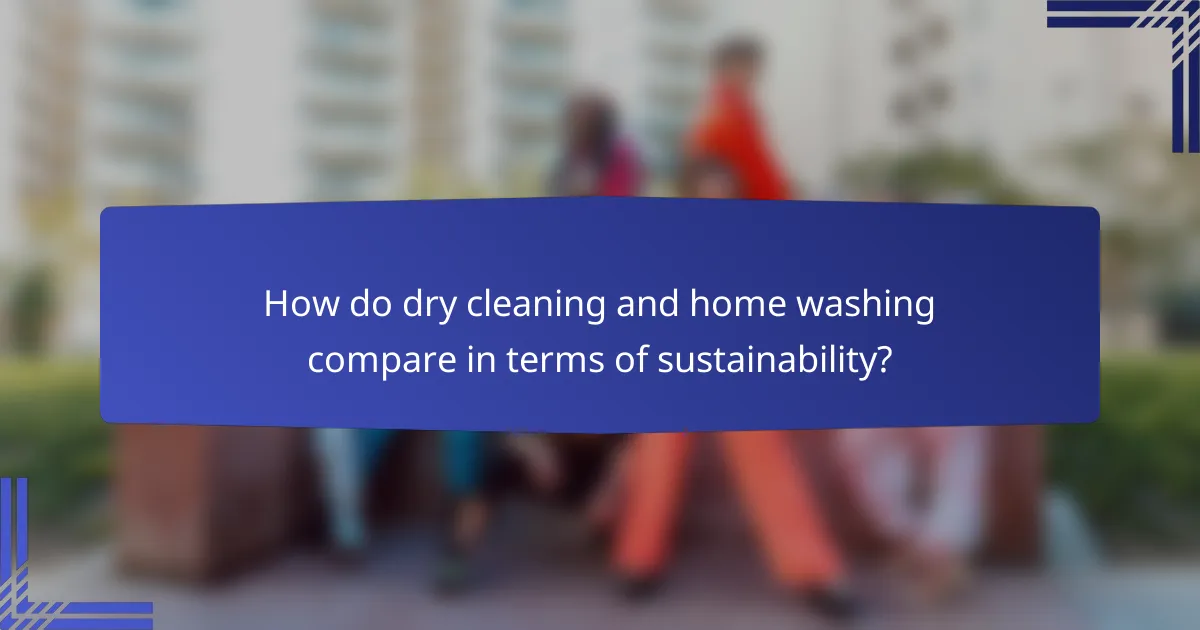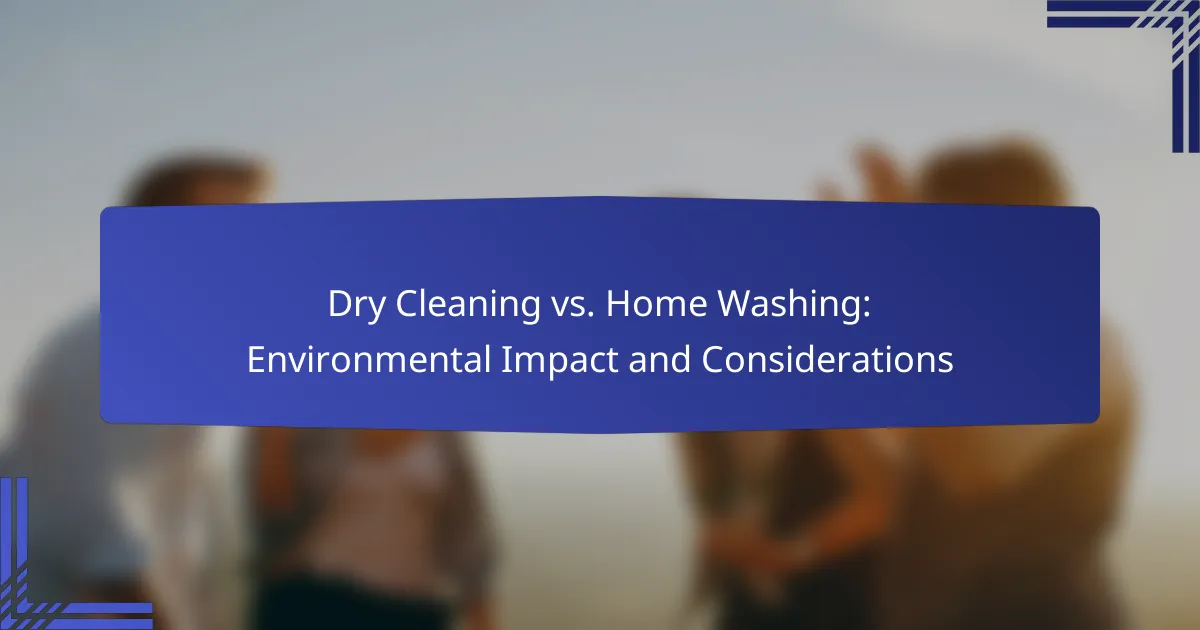The choice between dry cleaning and home washing carries significant environmental implications. Dry cleaning relies on harmful chemicals and consumes more water and energy, contributing to a larger carbon footprint. In contrast, home washing typically reduces chemical usage and conserves resources, making it a more eco-friendly option for garment care.

How does dry cleaning impact the environment?
Dry cleaning significantly impacts the environment through the use of harmful chemicals, high water consumption, and a notable carbon footprint. Understanding these factors can help consumers make informed choices about their garment care methods.
Use of harmful chemicals
Many dry cleaning processes utilize perchloroethylene (PERC), a solvent known for its effectiveness but also for its environmental and health risks. PERC can contaminate air and water sources, posing hazards to both ecosystems and human health.
Alternatives to traditional dry cleaning, such as wet cleaning or using biodegradable solvents, are becoming more popular. Consumers should look for dry cleaners that prioritize eco-friendly practices to minimize chemical exposure.
Water consumption
While dry cleaning uses less water than traditional washing methods, it still contributes to overall water consumption, especially when considering the entire lifecycle of the garments. The process requires water for rinsing and cleaning equipment, which can add up over time.
Home washing, particularly with energy-efficient machines, can be a more sustainable option. Choosing to wash clothes at home can significantly reduce water usage, especially if done with full loads and cold water settings.
Carbon footprint
The carbon footprint of dry cleaning is influenced by the energy used in the cleaning process and transportation of garments. The reliance on fossil fuels for energy and delivery contributes to greenhouse gas emissions.
To lower their carbon footprint, consumers can opt for local dry cleaning services to reduce transportation emissions or consider washing clothes at home. Using energy-efficient appliances can further minimize environmental impact.

What are the environmental benefits of home washing?
Home washing offers several environmental benefits compared to dry cleaning, primarily through reduced chemical usage, lower water waste, and improved energy efficiency. By opting for home washing, individuals can significantly lessen their ecological footprint while maintaining garment care.
Reduced chemical usage
Home washing typically employs biodegradable detergents that are less harmful to the environment than the solvents used in dry cleaning. Many dry cleaning processes involve perchloroethylene, a chemical linked to health risks and environmental pollution. In contrast, using eco-friendly detergents at home minimizes the release of harmful substances into water systems.
To maximize the benefits, choose detergents that are labeled as environmentally friendly and avoid those with phosphates or harsh chemicals. This simple switch can contribute to healthier waterways and ecosystems.
Lower water waste
Home washing can be more efficient in water usage, especially when using modern, high-efficiency washing machines. These machines often use significantly less water per load compared to older models or traditional dry cleaning methods. By washing full loads and selecting appropriate wash cycles, households can further reduce water consumption.
Consider using cold water settings whenever possible, as this not only conserves energy but also reduces the overall water footprint. Additionally, reusing rinse water for gardening or other non-potable uses can enhance water conservation efforts.
Energy efficiency
Home washing can be more energy-efficient than dry cleaning, particularly when using cold water and energy-efficient appliances. Many modern washing machines are designed to consume less electricity, which can lead to lower energy bills and reduced greenhouse gas emissions. Opting for air drying instead of using a dryer can further enhance energy savings.
To maximize energy efficiency, wash full loads and select shorter cycles when appropriate. This practice not only saves energy but also prolongs the lifespan of your garments, making it a win-win for both the environment and your wardrobe.

How do dry cleaning and home washing compare in terms of sustainability?
Dry cleaning and home washing differ significantly in their environmental impact. While home washing generally uses less energy and water, dry cleaning often involves harmful chemicals that can affect both the environment and human health.
Comparative analysis of processes
Home washing typically involves using water and detergent in a washing machine, which can be more eco-friendly if done efficiently. In contrast, dry cleaning uses solvents, such as perchloroethylene, which can be harmful to the environment if not properly managed. The choice of process can depend on the fabric type and the level of soiling.
For example, delicate fabrics like silk or wool may require dry cleaning, while cotton and synthetic materials can usually be washed at home. Consumers should consider fabric care labels and the environmental implications of their cleaning choices.
Long-term environmental effects
The long-term environmental effects of dry cleaning can be significant due to the use of toxic chemicals that may contaminate soil and water sources. Regulations in many countries are tightening around the use of these solvents, pushing for safer alternatives.
Home washing, when done responsibly, can minimize water usage and energy consumption, especially with modern, energy-efficient machines. However, improper washing practices, such as using excessive water or energy, can negate these benefits. Opting for cold water washes and full loads can enhance sustainability in home washing.

What are the cost implications of dry cleaning versus home washing?
The cost implications of dry cleaning compared to home washing can vary significantly based on factors like garment type, frequency of cleaning, and local pricing. Generally, dry cleaning tends to be more expensive due to the specialized processes and chemicals involved, while home washing is more economical and accessible for everyday laundry.
Average costs of dry cleaning
Dry cleaning costs typically range from $10 to $30 per garment, depending on the fabric and complexity of the cleaning process. Specialty items, such as formal wear or delicate fabrics, may incur higher fees. Additionally, some dry cleaners offer discounts for bulk cleaning or loyalty programs, which can help reduce overall expenses.
It’s important to consider that dry cleaning prices can vary by region. In urban areas, costs may be on the higher end of the spectrum, while smaller towns might offer more affordable options. Always check local listings to compare prices effectively.
Cost savings with home washing
Home washing is generally much cheaper, with costs primarily associated with water, detergent, and electricity. On average, washing a load of laundry at home can cost just a few dollars, making it a budget-friendly option for regular clothing maintenance.
To maximize savings, consider washing full loads and using cold water settings, which can reduce energy consumption. However, be cautious with delicate fabrics that may require special care, as improper washing can lead to damage and additional costs for replacements or repairs.

What are the health considerations for dry cleaning and home washing?
Health considerations for dry cleaning and home washing primarily revolve around exposure to chemicals and potential skin sensitivities. Understanding these factors can help consumers make informed choices about garment care.
Exposure to toxic substances
Dry cleaning often involves the use of perchloroethylene (PERC), a solvent linked to various health risks, including respiratory issues and skin irritation. In contrast, home washing typically utilizes water and detergents, which are generally safer but can still contain harmful ingredients.
To minimize exposure, consider using eco-friendly detergents at home and seek out dry cleaners that employ safer alternatives to PERC. Regulations in many countries are tightening around the use of toxic solvents, so look for certified establishments that adhere to these standards.
Skin sensitivity issues
Skin sensitivity can arise from both dry cleaning and home washing. Chemicals in dry cleaning solutions may cause allergic reactions or irritate sensitive skin, while certain laundry detergents can also trigger dermatitis or rashes.
To avoid these issues, opt for hypoallergenic detergents and ensure thorough rinsing of garments. If you have sensitive skin, it may be beneficial to test a small area of fabric before fully committing to a cleaning method.

How can consumers make eco-friendly choices in garment care?
Consumers can make eco-friendly choices in garment care by opting for sustainable cleaning methods and products. This includes selecting environmentally friendly detergents, reducing water usage, and considering the impact of dry cleaning chemicals.
Choosing eco-friendly detergents
When selecting eco-friendly detergents, look for products labeled as biodegradable and free from harmful phosphates and synthetic fragrances. These detergents are designed to break down more easily in the environment, minimizing pollution.
Consider using concentrated formulas, which require less packaging and reduce transportation emissions. Brands that prioritize sustainability often use plant-based ingredients and recyclable packaging, making them a better choice for the environment.
To further enhance your eco-friendly laundry routine, try using cold water for washing, as it saves energy and is effective with many eco-friendly detergents. Always check for certifications like the EPA’s Safer Choice label to ensure the product meets environmental standards.
